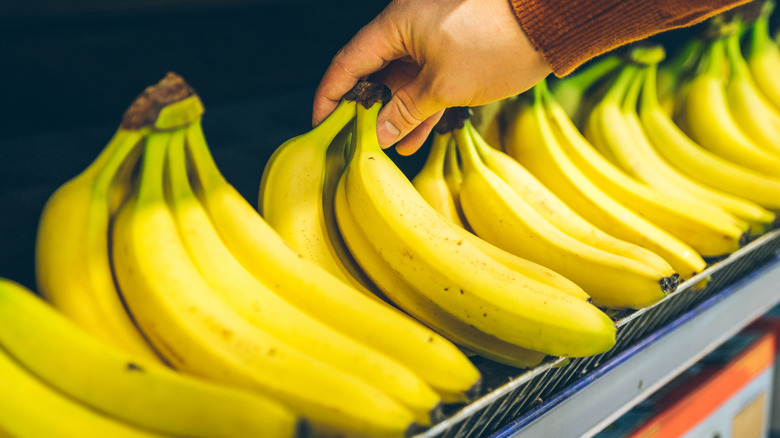Why The Price Of Trader Joe's Bananas Went Up In 2024
Fans of Trader Joe's know that there are some staples they can always count on, like those 19-cent bananas. Selling individual bananas is pretty genius, and by the time 2024 rolled around, the store had been doing that — at the same price — for about 20 years. It's what's known as a loss leader, which is basically an item that's sold for a loss but gets people in the door, spending more, and perhaps even shifting their shopping habits to make a store their go-to. Plenty of stores do it — it's one of the well-known secrets behind Costco's $4.99 rotisserie chickens.
Then, something surprising happened: The price of those single bananas went up to 23 cents. It doesn't seem like much of a jump, but it's more than a 20% increase in price. And it came years after the COVID pandemic, and well after headlines were filled with economists who were baffled by the continuously rising cost of food. Why did Trader Joe's finally raise the price on one of its most famous loss leaders?
A spokesperson told CNN that it had "reached a point where this change is necessary," and that's pretty vague. They also said that the prices customers are charged change only when corporate's costs change, and it turns out that there's a strange thing that's going on with bananas. After holding steady for a long time, fears of scarcity and the spiraling impacts of climate change have sent prices up, up, and up.
Fears over the future of banana crops began in Rome
Specifically, concerns were raised at the 2024 World Banana Forum in Rome, and there were a few things at work here. Professor and sustainable agriculture specialist Dan Bebber told CBS News, "Producers like Guatemala, El Salvador, and Costa Rica will see a negative impact of rising temperatures over the next few decades," and that was going to have a twofold impact: In addition to making temperatures too hot for farmers to reliably produce large banana crops, it was also encouraging the spread of a devastating and impossible-to-eradicate fungus called the TR4 fungus.
Trader Joe's also pointed out that it's lowered some of their other produce prices, but what's up with bananas? The problem is that bananas are genetically identical, which means that when there's one outbreak of disease or fungus, it impacts the entire world's crops. In 2022, scientists were already warning (via The Oxford Scientist) that there was a very good chance that bananas were going to go the way of the dodo. It had, after all, happened before: The Gros Michel banana was all but wiped out by a fungal outbreak in the 1950s and '60s.
Bebber and other experts hope that by raising prices now, banana-producing countries will be able to invest in infrastructure, higher wages, and other measures to help protect future banana crops and farmers — including funding oversight designed to make banana production more sustainable. All that means banana prices are likely to remain high in the foreseeable future, and you just might want to try that three-ingredient banana bread while you still can.

